
Pushkin is a municipal town in Pushkinsky District of the federal city of St. Petersburg, Russia, located 24 kilometers (15 mi) south from the center of St. Petersburg proper, and its railway station, Tsarskoye Selo, is directly connected by railway to the Vitebsky Rail Terminal of the city. Population: 92,889 (2010 Census).
The Fontanka, a left branch of the river Neva, flows through the whole of Central Saint Petersburg, Russia – from the Summer Garden to Gutuyevsky Island. It is 6.7 kilometres (4.2 mi) long, with a width up to 70 metres (230 ft), and a depth up to 3.5 metres (11 ft). The Moyka River forms a right-bank branch of the Fontanka. Lined along the Fontanka Embankment stand the former private residences of Russian nobility.

Nevsky Prospect is a main street located in the federal city of St. Petersburg in Russia. Its name comes from the Alexander Nevsky Lavra, the monastery which stands at the eastern end of the street, and which commemorates the Russian hero Prince Saint Alexander Nevsky (1221–1263). Following his founding of Saint Petersburg in 1703, Tsar Peter I planned the course of the street as the beginning of the road to Novgorod and Moscow. The avenue runs from the Admiralty in the west to the Moscow Railway Station and, after veering slightly southwards at Vosstaniya Square, to the Alexander Nevsky Lavra.

Palace Square, connecting Nevsky Prospekt with Palace Bridge leading to Vasilievsky Island, is the central city square of St Petersburg and of the former Russian Empire. Many significant events took place there, including the Bloody Sunday massacre and parts of the October Revolution of 1917. Between 1918 and 1944, it was known as Uritsky Square, in memory of the assassinated leader of the city's Cheka branch, Moisei Uritsky.
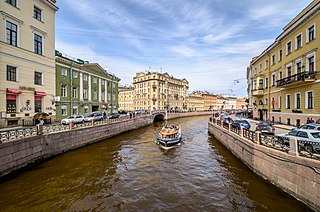
The Moyka is a secondary, in comparison with the Neva River in Saint Petersburg that encircles the central portion of the city, effectively making it an island or a group of islands, together with the Neva, the Fontanka, and canals including the Griboyedov and Kryukov. The river derives its name from the Ingrian word Muya for "slush" or "mire", having its original source in former swamp. It is 5 kilometres (3 mi) long and 40 metres (130 ft) wide.
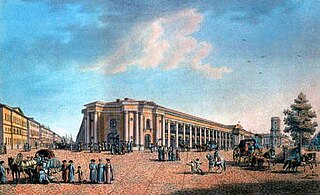
Great Gostiny Dvor is a vast department store on Nevsky Avenue in St Petersburg, Russia.
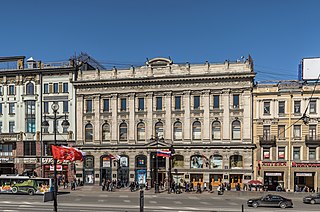
The Passage, from the French word passage, is an élite department store on Nevsky Avenue in Saint Petersburg, Russia, which was founded in 1848. The Passage premises have long had associations with the entertainment industry and houses the Komissarzhevskaya Theatre.

Marian Marianovich Peretyatkovich was a Russian and Polish architect. His premature death at the age of 43 limited his career to only eight years of independent practice (1908-1916), however, he managed to excel in a rational (Finnish) variety of late Art Nouveau, Renaissance Revival and Russian Revival in Saint Petersburg and Moscow. He is sometimes compared with Louis Sullivan on account of his insistence on functionality of office buildings.
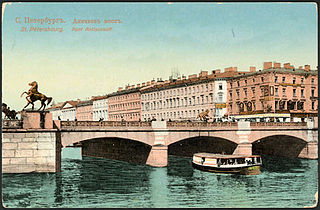
The Anichkov Bridge is the oldest and most famous bridge across the Fontanka River in Saint Petersburg, Russia. The current bridge, built in 1841-42 and reconstructed in 1906-08, combines a simple form with some spectacular decorations. As well as its four famous horse sculptures (1849–50), the bridge has some of the most celebrated ornate iron railings in Saint Petersburg. The structure is mentioned in the works of Pushkin, Gogol, and Dostoevsky.
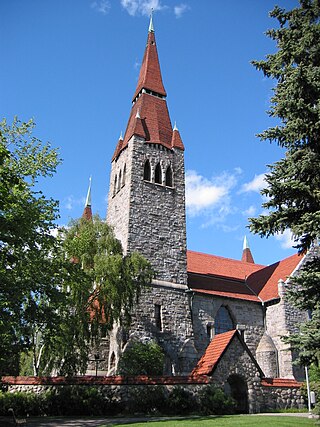
The National Romantic style was a Nordic architectural style that was part of the National Romantic movement during the late 19th and early 20th centuries. It is often considered to be a form of Art Nouveau.

Tauride Palace is one of the largest and most historically important palaces in Saint Petersburg, Russia.

Elisseeff Emporium in St. Petersburg is a large retail and entertainment complex, including a famous food hall, constructed in 1902–1903 for the Elisseeff Brothers. Located at 56 Nevsky Prospekt, the complex consists of three buildings, although the corner one is the structure that is referred to as Elisseeff's store or shop. Designed by architect Gabriel Baranovskii, it is one of the most striking examples of St. Petersburg Art Nouveau architecture, although at the time of its construction the building was considered controversial.

The Wawelbergs were a Polish family whose banking house was active in both Congress Poland and the Russian Empire.
Michael Wawelberg was a Polish-Russian Jewish banker, one of the best known members of the Wawelberg banking family.

The Stroganov Palace is a Late Baroque palace at the intersection of the Moika River and Nevsky Prospect in St. Petersburg, Russia. The palace was built to Bartolomeo Rastrelli's designs for Baron Sergei Grigoriyevich Stroganov in 1753–1754. The interiors were remodeled by Andrei Voronikhin at the turn of the 19th century.

The Tolstoy House is a well-known apartment building in St. Petersburg, located at 15-17 Rubinstein Street and 54 Fontanka Embankment. The building was constructed in 1910–1912 under the aegis of Major-General Count Mikhail Pavlovich Tolstoy, nephew of the 1812 war hero P. A. Tolstoy. The architect Fyodor Lidval designed it in Nordic Art Nouveau. The construction is interesting for its inner street with three connected yards where the facades were decorated as richly as the front ones. Three-storey arches leading to the inner street are the architectural dominants of the compositions.
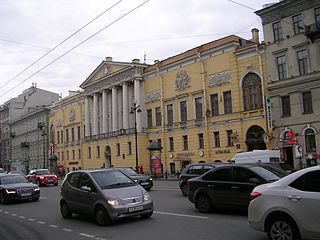
Nevsky Prospect 86 is a neoclassical palace situated on the Nevsky Prospect in St Petersburg, Russia. It is also known as the Palace of Arts or the Palace of Zinaida Yusupova.



















